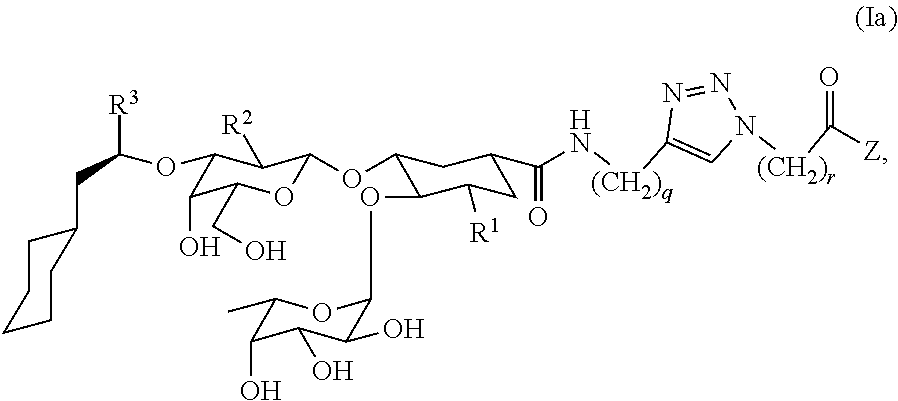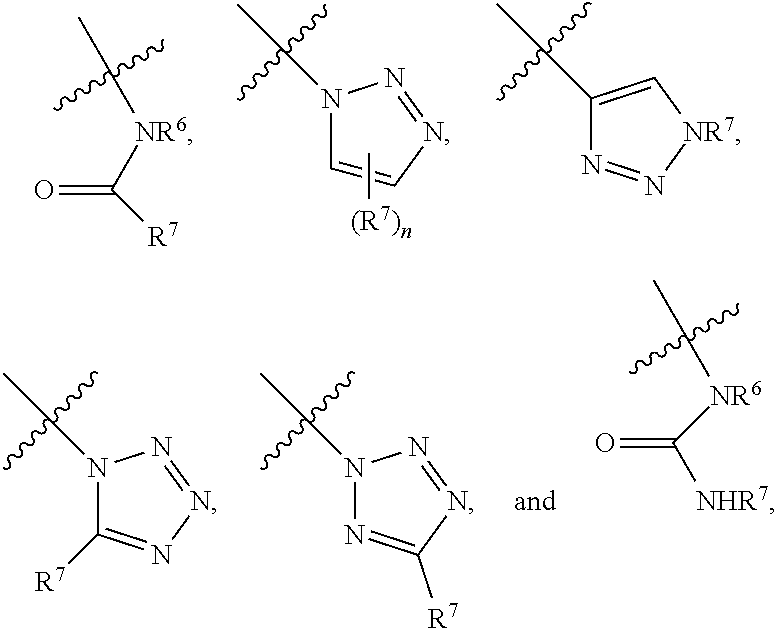Heterobifunctional Pan-Selectin Antagonists Having a Triazole Linker
a triazole linker and antagonist technology, applied in the field of heterofunctional panselectin antagonists having triazole linkers, can solve the problems of tissue damage instead of repair, unsuitability of glycomimetics for drug development,
- Summary
- Abstract
- Description
- Claims
- Application Information
AI Technical Summary
Benefits of technology
Problems solved by technology
Method used
Image
Examples
example 1
Synthesis of Seletin Modulators 15a-c (FIG. 1)
[0156]Synthesis of Compound 2:
[0157]A suspension of compound 1 (500 mg, 1.19 mmol, purity approximately 75%; synthesized as described by Schwizer et al., Chem. Eur. J. 18:1342-1351, 2012) and Pd(OH)2 / C (10%) in dioxane / water (4:1, 5 mL) is stirred under a hydrogen atmosphere at room temperature for 24 hours. Then the reaction mixture is filtered over celite and washed with methanol. The filtrate is evaporated to dryness and the crude product is purified by column chromatography on silica gel (petroleum ether / diethyl ether, 9:1) to afford compound 2 (360 mg, quant.) as a yellowish oil. [α]D20 −16.5 (c 1.14, CH2Cl2); 1H NMR (500 MHz, CDCl3): δ=0.10 (s, 3H, SiCH3), 0.10 (s, 3H, SiCH3), 0.90 (s, 9H, C(CH3)3), 0.89-0.93 (m, 3H, CH3), 1.12-1.22 (m, 2H, H-6a, OH), 1.26 (m, 1H, CH2), 1.37 (m, 1H, H-5), 1.53 (m, 1H, H-2a), 1.85 (m, 1H, CH2), 2.01 (m, 1H, H-6b), 2.07 (ddd, J=4.0, 6.2, 12.7 Hz, 1H, H-2b), 2.40 (m, 1H, H-1), 3.07 (dd, J=8.6, 10.1 Hz...
example 2
Synthesis of Seletin Modulator 17 (FIG. 2)
[0180]Synthesis of Compound 17:
[0181]According to the procedure for compound 15a, compound 16 (3.3 mg, 4.1 μmol, synthesized as described by Egger et al., J. Am. Chem. Soc. 135:9820-9828, 2013) and compound 14a (3.4 mg, 6.2 μmol) in the presence of cupric sulfate pentahydrate (0.25 mg, 1.0 μmol) and L-(+)-ascorbic acid sodium salt (0.40 mg, 2.1 μmol) to yield compound 17 (3.2 mg, 57%) as a white solid. [α]D20 −16.5 (c 0.25, MeOH); 1H NMR (500 MHz, D2O): 6=0.19-0.33, 0.37-0.49, 0.54-0.76, 0.92-1.04, 1.07-1.23, 1.31-1.43 (15H, C7HDL, H-2a, H-6a), 1.06 (d, J=6.5 Hz, 3H, CH3), 1.30 (d, J=6.5 Hz, 3H, H-6F), 1.55 (d, J=13.9 Hz, 1H, H-6b), 1.62 (m, 1H, H-5), 1.70 (tt, J=4.3, 7.6 Hz, 2H, CH2), 2.11 (m, 1H, H-2b), 2.24 (ddd, J=3.8, 12.7, 16.5 Hz, 1H, H-1), 2.67 (dd, J=6.9, 8.3 Hz, 2H, CH2), 2.90-3.03 (m, 2H, CH2), 3.12 (t, J=9.7 Hz, 1H, H-4), 3.20 (dd, J=5.3, 7.4 Hz, 2H, CH2), 3.71 (ddd, J=4.7, 9.3, 11.4 Hz, 1H, H-3), 3.77-3.85 (m, 6H, H-3G, H-5G, H-...
example 3
Synthesis of Compounds 14a-c (FIG. 3)
[0182]Synthesis of Compound 18:
[0183]A mixture of 3-chloropropanoic acid (150 mg, 1.38 mmol) and NaN3 (898 mg, 13.8 mmol) in water (3 mL) is stirred at reflux. After 22 hours, the reaction mixture is cooled to room temperature, acidified with aqueous HCl and extracted with diethyl ether. The organic layer is dried with Na2SO4 and evaporated to dryness to give 3-azidopropanoic acid, compound 18, (130 mg, 81%).
[0184]Synthesis of Compound 14a:
[0185]To a solution of compound 18 (16.0 mg, 0.139 mmol) in DMF (300 DIPEA (40 μL) and COMU (71 mg, 0.167 mmol) are added successively at 0° C. After 5 minutes, a pre-cooled (0° C.) mixture of sodium 8-aminonaphthalene-1,3,6-trisulfonate (19) (62.0 mg, 0.146 mmol) and DIPEA (40 μL) in DMF (300 μL) is added dropwise. After 1 hour at 0° C., the reaction mixture is stirred for additional 21 hours at room temperature. Evaporation of the solvent and purification by chromatography on silica gel (DCM / MeOH / water, 10:5:...
PUM
| Property | Measurement | Unit |
|---|---|---|
| temperature | aaaaa | aaaaa |
| temperature | aaaaa | aaaaa |
| pH | aaaaa | aaaaa |
Abstract
Description
Claims
Application Information
 Login to View More
Login to View More - R&D
- Intellectual Property
- Life Sciences
- Materials
- Tech Scout
- Unparalleled Data Quality
- Higher Quality Content
- 60% Fewer Hallucinations
Browse by: Latest US Patents, China's latest patents, Technical Efficacy Thesaurus, Application Domain, Technology Topic, Popular Technical Reports.
© 2025 PatSnap. All rights reserved.Legal|Privacy policy|Modern Slavery Act Transparency Statement|Sitemap|About US| Contact US: help@patsnap.com



